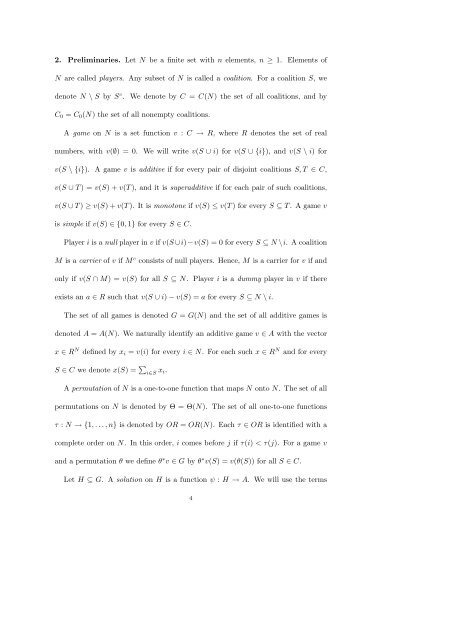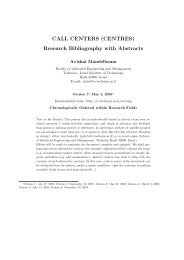Variations on the Shapley value
Variations on the Shapley value
Variations on the Shapley value
You also want an ePaper? Increase the reach of your titles
YUMPU automatically turns print PDFs into web optimized ePapers that Google loves.
2. Preliminaries. Let N be a finite set with n elements, n ≥ 1. Elements of<br />
N are called players. Any subset of N is called a coaliti<strong>on</strong>. For a coaliti<strong>on</strong> S, we<br />
denote N \ S by S c . We denote by C = C(N) <strong>the</strong> set of all coaliti<strong>on</strong>s, and by<br />
C0 = C0(N) <strong>the</strong> set of all n<strong>on</strong>empty coaliti<strong>on</strong>s.<br />
A game <strong>on</strong> N is a set functi<strong>on</strong> v : C → R, where R denotes <strong>the</strong> set of real<br />
numbers, with v(∅) = 0. We will write v(S ∪ i) for v(S ∪ {i}), and v(S \ i) for<br />
v(S \ {i}). A game v is additive if for every pair of disjoint coaliti<strong>on</strong>s S, T ∈ C,<br />
v(S ∪ T ) = v(S) + v(T ), and it is superadditive if for each pair of such coaliti<strong>on</strong>s,<br />
v(S ∪ T ) ≥ v(S) + v(T ). It is m<strong>on</strong>ot<strong>on</strong>e if v(S) ≤ v(T ) for every S ⊆ T . A game v<br />
is simple if v(S) ∈ {0, 1} for every S ∈ C.<br />
Player i is a null player in v if v(S ∪i)−v(S) = 0 for every S ⊆ N \i. A coaliti<strong>on</strong><br />
M is a carrier of v if M c c<strong>on</strong>sists of null players. Hence, M is a carrier for v if and<br />
<strong>on</strong>ly if v(S ∩ M) = v(S) for all S ⊆ N. Player i is a dummy player in v if <strong>the</strong>re<br />
exists an a ∈ R such that v(S ∪ i) − v(S) = a for every S ⊆ N \ i.<br />
The set of all games is denoted G = G(N) and <strong>the</strong> set of all additive games is<br />
denoted A = A(N). We naturally identify an additive game v ∈ A with <strong>the</strong> vector<br />
x ∈ R N defined by xi = v(i) for every i ∈ N. For each such x ∈ R N and for every<br />
S ∈ C we denote x(S) = <br />
i∈S xi.<br />
A permutati<strong>on</strong> of N is a <strong>on</strong>e-to-<strong>on</strong>e functi<strong>on</strong> that maps N <strong>on</strong>to N. The set of all<br />
permutati<strong>on</strong>s <strong>on</strong> N is denoted by Θ = Θ(N). The set of all <strong>on</strong>e-to-<strong>on</strong>e functi<strong>on</strong>s<br />
τ : N → {1, . . . , n} is denoted by OR = OR(N). Each τ ∈ OR is identified with a<br />
complete order <strong>on</strong> N. In this order, i comes before j if τ(i) < τ(j). For a game v<br />
and a permutati<strong>on</strong> θ we define θ ∗ v ∈ G by θ ∗ v(S) = v(θ(S)) for all S ∈ C.<br />
Let H ⊆ G. A soluti<strong>on</strong> <strong>on</strong> H is a functi<strong>on</strong> ψ : H → A. We will use <strong>the</strong> terms<br />
4
















